
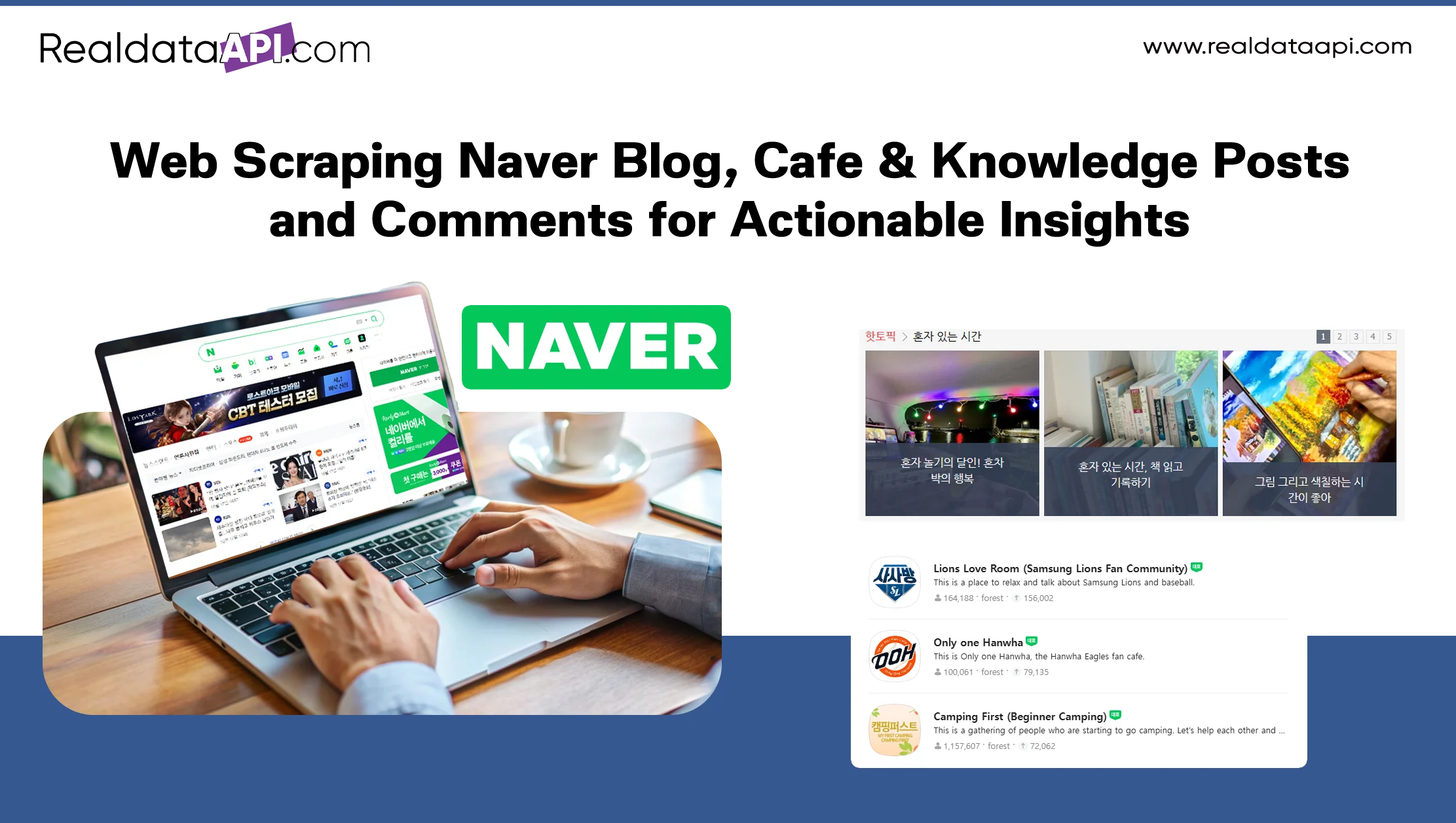
Introduction
In South Korea, Naver dominates the digital landscape as the most popular search engine and social platform, far surpassing Google in user engagement. With its ecosystem of interconnected services — Naver Blog, Naver Café, and Naver Knowledge (지식iN) — the platform hosts billions of user-generated posts, discussions, and opinions across virtually every topic imaginable.
For marketers, researchers, and data-driven companies, this ecosystem is a goldmine of insights. By using Naver Scraping API, you can collect structured data from blogs, forums, and Q&A sections — including posts, comments, likes, replies, and timestamps — to understand trends, public sentiment, and user behavior.
This article explores the complete process of Post and Comment Data Collection from Naver Blog, Naver Café, and Naver Knowledge as well as how to Scrape Naver Blogs, Cafe & Knowledge Posts and Comments its applications, benefits, and best practices for ethical web scraping.
Understanding Naver's Ecosystem
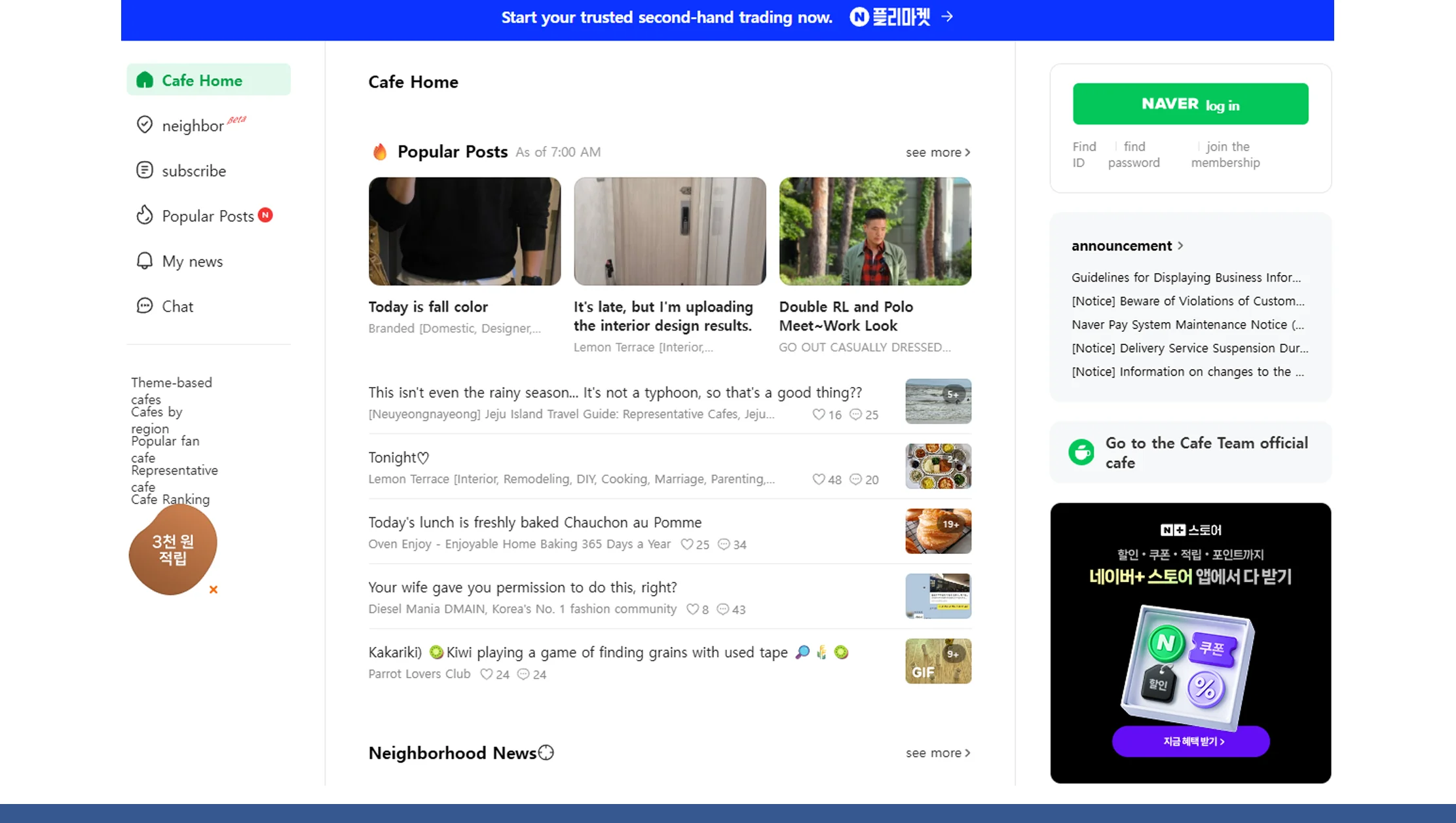
Before diving into data extraction, it's essential to understand how Naver's main community-driven products function and why they are valuable for businesses and researchers.
1. Naver Blog (네이버 블로그)
Naver Blog is Korea's equivalent of Medium or WordPress — but with much higher engagement. Millions of users post daily content related to:
- Product reviews (beauty, fashion, electronics, food)
- Lifestyle and travel experiences
- Tutorials and how-to guides
- Brand endorsements and influencer marketing
Each blog post includes comments, likes, hashtags, and engagement metrics, which are critical for sentiment and influencer analysis.
2. Naver Café (네이버 카페)
Naver Café is a community forum network where people join interest-based groups (like Reddit communities or Facebook groups). It's widely used for:
- Hobby discussions (cars, pets, gaming, cooking)
- Local community updates
- Job listings and educational exchanges
- Consumer feedback and reviews
Each Café post has comments, replies, and engagement data that reflect real user sentiment.
3. Naver Knowledge (지식iN / Naver Knowledge iN)
This is Naver's Q&A platform, similar to Quora or Yahoo! Answers. Users ask questions and receive expert or community answers. Common use cases:
- Product troubleshooting
- Health and lifestyle advice
- Legal and financial guidance
Collecting Naver Knowledge Q&A data helps identify information gaps, common pain points, and emerging trends in user queries.
Why Scrape Naver Blog, Café, and Knowledge Data?
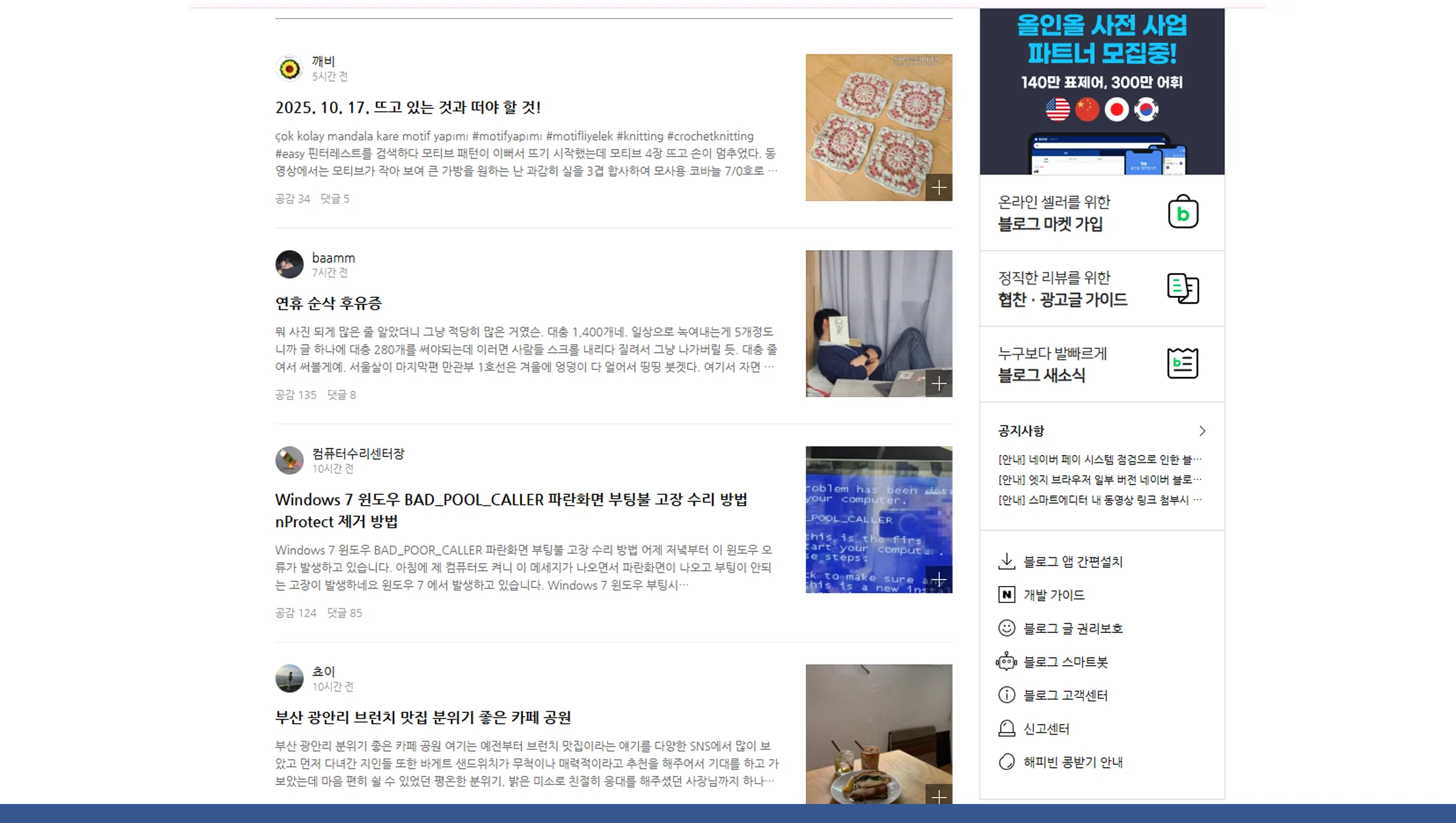
Naver's ecosystem generates one of the most active user communities in Asia. With millions of daily active users, the volume of publicly available data is immense. The ability to Scrape Naver Blogs, Cafe & Knowledge Posts and Comments provides unique advantages for data-driven decision-making:
1. Market Research and Trend Analysis
Scraping Naver Blogs or Cafés provides insight into:
- Popular products or services
- Trending discussions in different demographics
- Emerging topics within specific industries (e.g., K-beauty, K-pop, tech, real estate)
2. Sentiment and Opinion Mining
Naver comments and discussions reflect real-time customer emotions toward brands or public figures. By scraping comment data, companies can:
- Monitor brand reputation
- Detect early signs of customer dissatisfaction
- Measure campaign sentiment
3. Competitor Analysis
Track what users are saying about competing products on Naver Blogs and Cafés to analyze:
- Strengths and weaknesses from user feedback
- Price comparisons
- User perception differences by region
4. Influencer Discovery
Identify top Naver Bloggers or Café moderators driving engagement in your niche. Scraping follower counts, likes, and comment interactions can help brands find genuine influencers for partnerships.
5. Academic and Linguistic Research
Linguists and researchers use Naver data to:
- Study Korean language usage and cultural expressions
- Track sentiment changes across time periods
- Build training datasets for Korean NLP models
What Kind of Data Can Be Collected from Naver Platforms?
Naver's services share a similar content structure. Scraping can capture both post-level and comment-level data from each section.
| Platform | Data Type | Examples of Fields Collected |
|---|---|---|
| Naver Blog | Posts & Comments | Blog ID, Author Name, Title, Post Content, Tags, Images, Published Date, Likes, Views, Comment Count, Comments (Text, Author, Timestamp) |
| Naver Café | Forum Threads & Replies | Café Name, Topic, Author, Post Text, Category, Likes, Views, Comment Text, Nested Replies |
| Naver Knowledge (지식iN) | Questions & Answers | Question Title, Question Text, Category, Answer Count, Upvotes, Answer Text, Answerer Info, Timestamp |
These datasets can be stored in structured formats like CSV, JSON, or databases such as MySQL, MongoDB or Social Media Data Scraping API workflows for analysis.
How Web Scraping Works for Naver Platforms
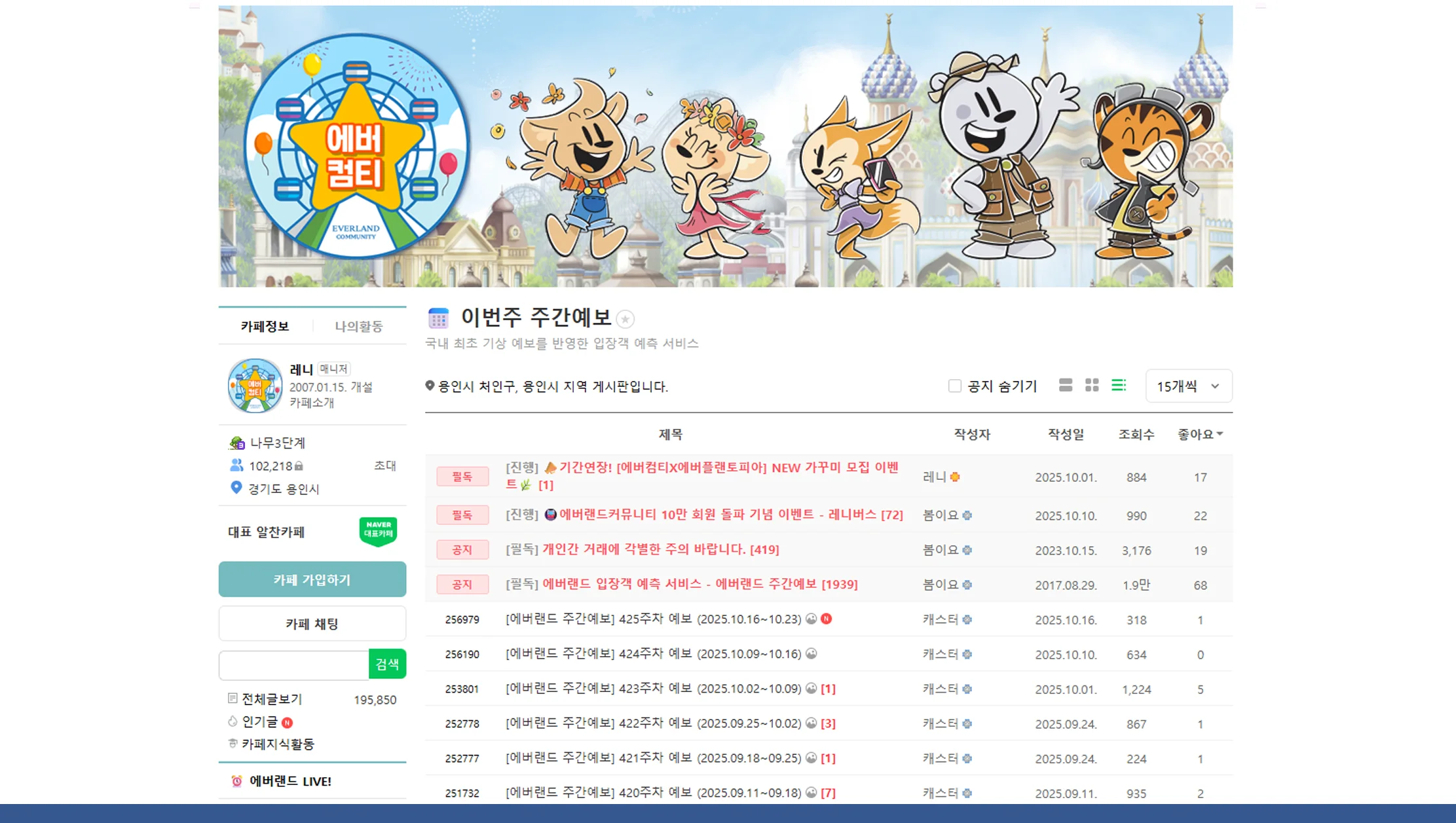
Scraping Naver's multi-layered structure requires careful planning, especially since many components are loaded dynamically. Here's a step-by-step overview:
Step 1: Identify Target URLs
Each section (Blog, Café, Knowledge) has a unique base URL:
- Naver Blog: https://blog.naver.com/
- Naver Café: https://cafe.naver.com/
- Naver Knowledge: https://kin.naver.com/
Map your search queries and categories (e.g., "EV cars", "K-beauty", "travel reviews").
Step 2: Access Page Source and Analyze HTML Structure
Inspect the elements using browser developer tools to locate:
- Post title tags (e.g., <h3>, <h2>)
- Comment sections (<div class="comment_list">)
- Author metadata and timestamps
Step 3: Choose the Right Scraping Tools
Since Naver heavily uses JavaScript and dynamic loading, traditional HTML parsers may not be sufficient. Recommended tools include:
- Python + Selenium – to automate browsing and load comments.
- Playwright – for modern headless browser scraping.
- Scrapy – for scalable data crawling.
- BeautifulSoup – for HTML parsing post-rendering.
Step 4: Extract Data
Use defined selectors or XPath queries to extract text, timestamps, and metadata. Store them in structured form:
{
"post_title": "Top 10 EV Cars in Korea 2025",
"author": "AutoTalkKorea",
"date": "2025-10-10",
"comments": [
{"user": "speedy123", "text": "Great review!", "date": "2025-10-11"},
{"user": "carlover", "text": "I prefer Hyundai Ioniq 6.", "date": "2025-10-12"}
]
}Step 5: Handle Pagination and Comments
Naver comments often load after scrolling or clicking a "View More" button. Implement dynamic scrolling or AJAX request monitoring to collect full thread data.
Step 6: Store and Clean Data
Remove duplicates, trim text, and filter unwanted content (ads, signatures, etc.). Save data in an analysis-ready format.
Overcoming Technical Challenges in Naver Data Collection
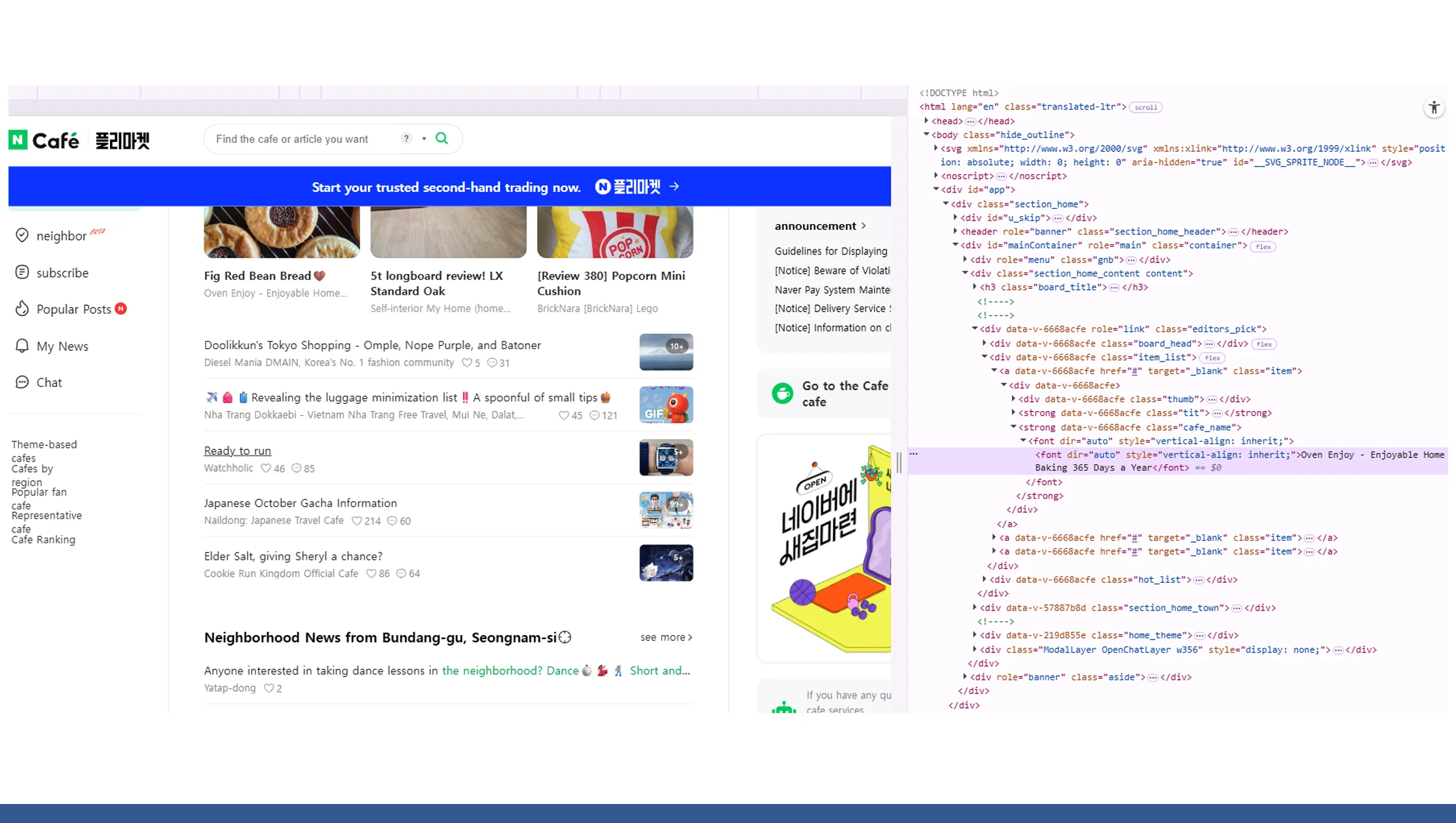
1. JavaScript Rendering
Naver loads content dynamically, especially comment threads. Solution: Use browser automation tools (Selenium or Playwright) to execute JavaScript and render full pages.
2. Korean Language Encoding
Ensure UTF-8 encoding when saving or reading data to avoid broken characters. Solution: Apply text normalization for Hangul characters.
3. IP Blocking & Rate Limits
Naver may limit repeated requests from the same IP. Solution: Use rotating proxies and user-agent randomization to distribute traffic.
4. Anti-Bot Mechanisms
CAPTCHAs and login barriers may appear. Solution: For public posts, scraping without login is ideal. For Café communities, you may need authorized access tokens.
5. Nested Comment Threads
Comments on Naver Café often contain multiple reply levels. Solution: Recursively scrape child comment elements using a depth-based parsing approach.
Use Cases of Naver Post and Comment Data Collection
1. Brand Sentiment Analysis
By collecting comments and replies from blogs and cafés, companies can gauge public sentiment toward new products or campaigns.
- Example: A cosmetics brand analyzing feedback on its latest skincare line.
- Output: Positive/Negative sentiment ratio by keyword.
2. Social Listening and Trend Discovery
Analyze trending topics in specific communities.
- Example: Discovering that "eco-friendly vehicles" are gaining traction in automotive cafés.
3. Product Review Aggregation
Aggregate reviews across Naver Blogs to identify customer preferences.
- Example: Collecting reviews of new smartphones or K-pop albums for comparison charts.
4. Opinion Mining in Naver Knowledge
Extracting answers from Knowledge iN to understand public perception of services (e.g., telecom operators or financial products).
5. Customer Support Insights
Companies can scrape product-related Q&A data to:
- Identify common support issues.
- Create better FAQ sections.
- Improve chatbot training datasets.
6. Influencer & Community Mapping
Scraping user engagement metrics helps map influential Café moderators or top bloggers, assisting in influencer marketing strategy.
7. Research and NLP Training
Large-scale Naver post and comment data helps build Korean sentiment analysis, chatbots, or translation models.
Sample Data Schema for Naver Blog and Café Scraping
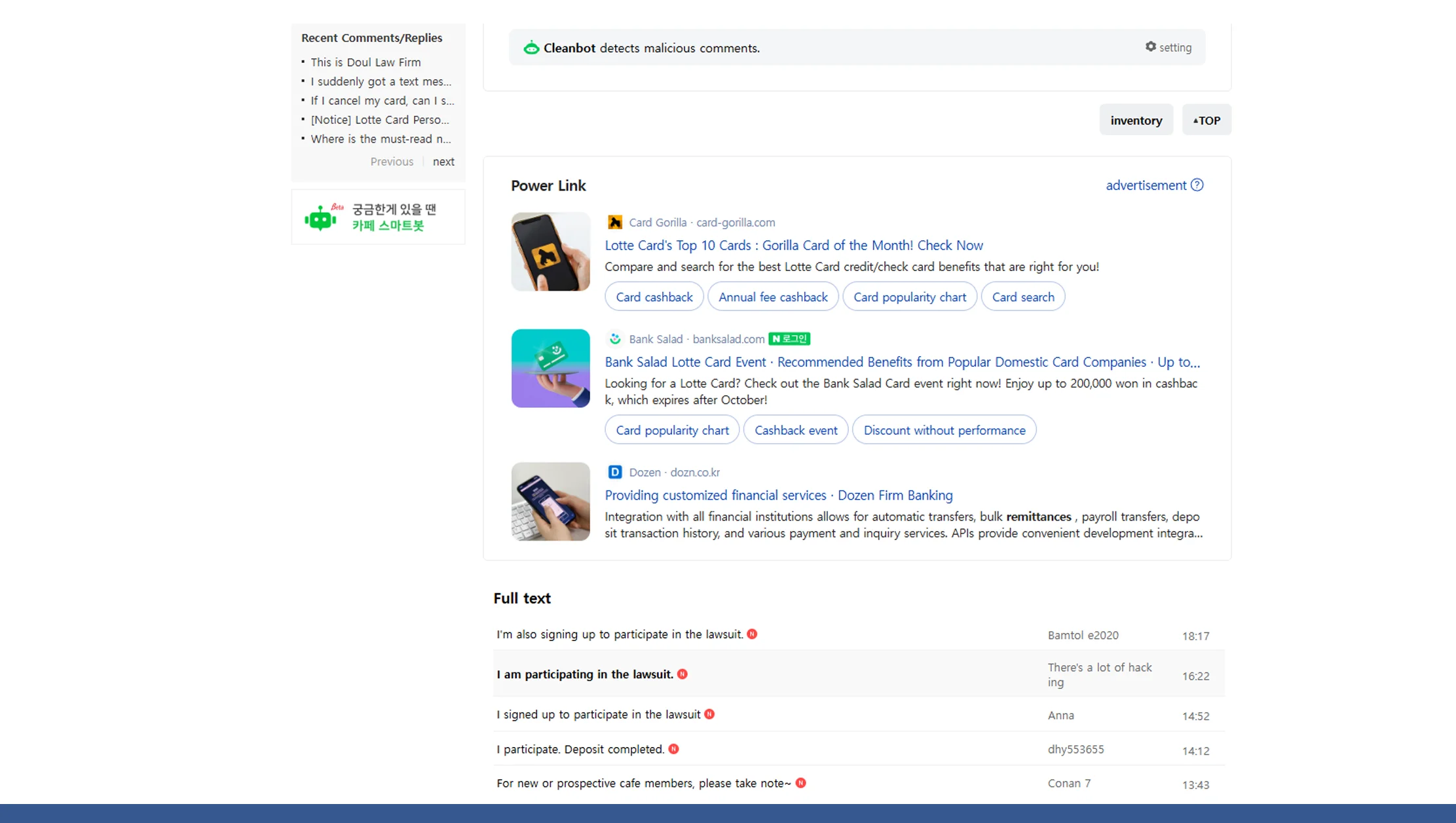
| Field | Description |
|---|---|
| Platform | Naver Blog / Café / Knowledge |
| Post ID | Unique identifier |
| Post Title | Blog or discussion title |
| Author | Username or nickname |
| Post Date | Date of publication |
| Content | Full text of post |
| Likes / Views | Engagement metrics |
| Comments | List of comment texts and replies |
| Tags / Keywords | Extracted tags or hashtags |
| URL | Direct link to the post |
This structured dataset can feed into BI tools, machine learning pipelines, or data dashboards.
Analyzing and Visualizing Naver Data
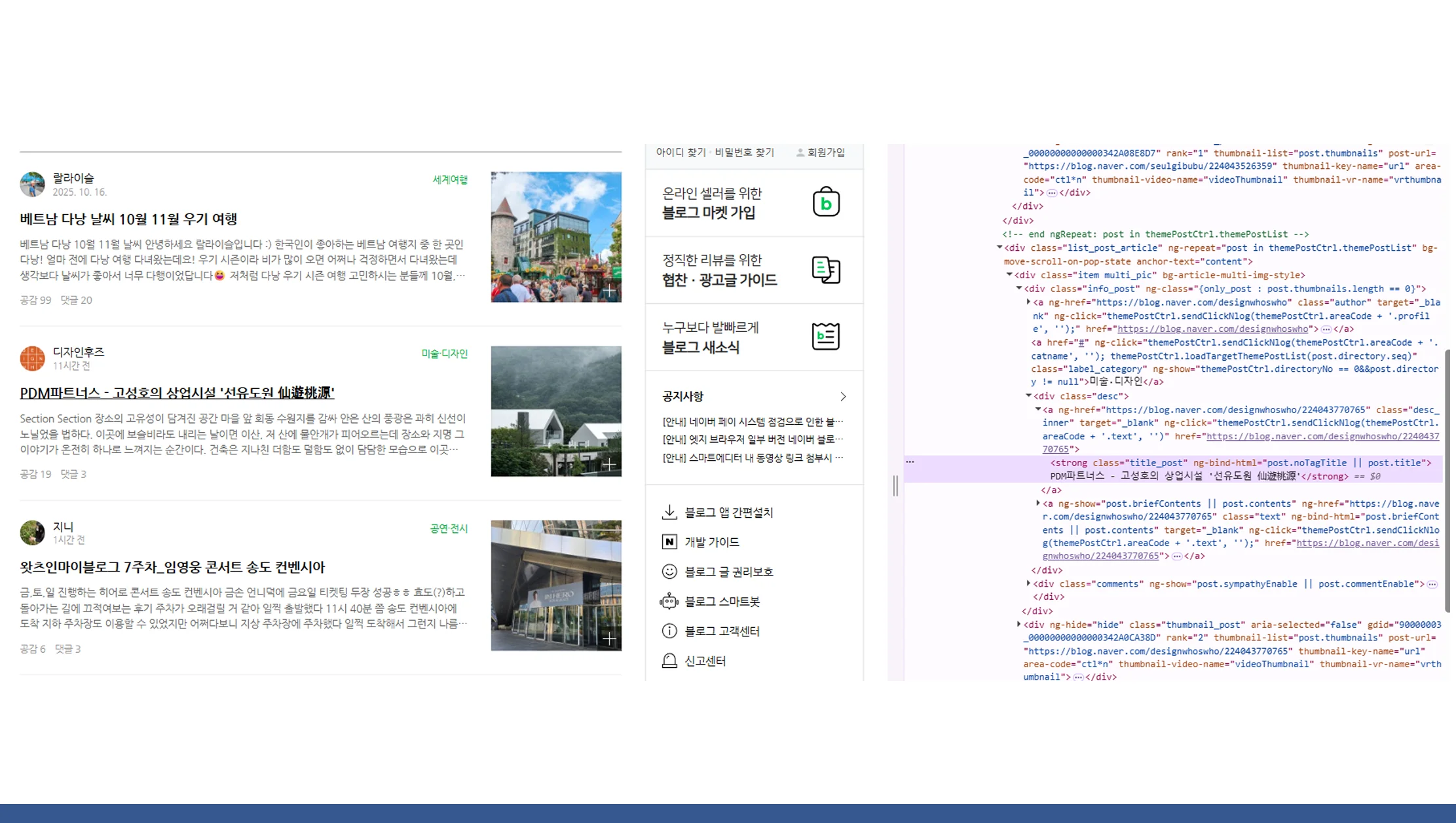
Once the post and comment data is collected, businesses can use analytics tools for deeper insights:
- Power BI / Tableau: For visual dashboards (e.g., keyword frequency, sentiment by region).
- Python (NLTK / TextBlob / KoNLPy): For Korean text processing and sentiment classification.
- Google Data Studio: For simplified, shareable dashboards.
- Elasticsearch + Kibana: For search-based exploration of scraped content.
You can track:
- Trending words or hashtags.
- Sentiment changes over time.
- Engagement distribution across platforms.
Ethical Web Scraping and Compliance
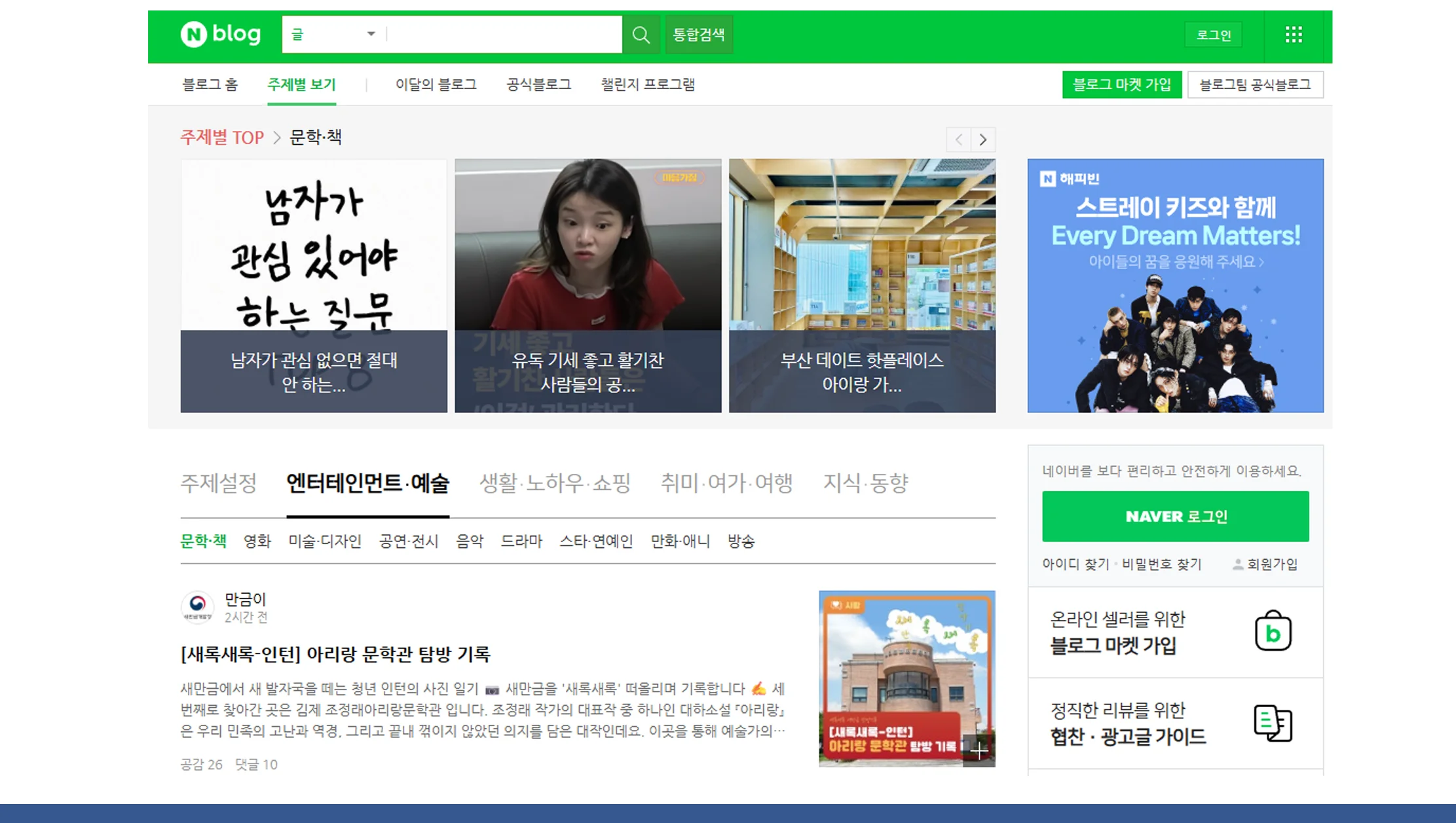
Scraping user-generated content must always respect privacy and data use guidelines. Follow these best practices:
- Scrape only publicly available posts and comments.
- Avoid private Café groups or password-protected blogs.
- Use scraping at moderate frequencies to prevent server overload.
- Respect robots.txt directives.
- Anonymize user IDs when analyzing or publishing insights.
Real Data API strictly adheres to ethical and legal guidelines, offering safe and compliant Web Scraping Services for Korean platforms.We ensure all data collection adheres to global compliance standards such as GDPR and Korean PIPA (Personal Information Protection Act).
How Real Data API Helps with Naver Data Collection
Real Data API specializes in Korean market data extraction, offering automated tools Naver Blog Scraper to collect and organize post and comment data from Naver Blog, Café, and Knowledge.
Our Services Include:
- Full post and comment scraping (public data only)
- Sentiment classification-ready datasets
- Real-time data APIs for continuous updates
- Cleaned and structured outputs in JSON, CSV, or Excel
- Support for multi-language translation (Korean → English)
Benefits of Choosing Real Data API:
- No manual effort – fully automated pipeline
- Fast turnaround time for large data volumes
- Scalable architecture for tracking trends over time
- Ethical and compliant data extraction methods
- 24/7 support for Korean data projects
Whether you're conducting brand analysis, academic research, or competitor benchmarking, we deliver high-quality structured data tailored to your needs.
Conclusion
Collecting post and comment data from Naver Blog, Naver Café, and Naver Knowledge opens a new world of insights for brands, researchers, and analysts. This data reveals authentic consumer opinions, emerging discussions, and valuable feedback that can guide strategic decisions in marketing, product design, and customer engagement.
By leveraging Naver scraping solutions, you can transform unstructured web data into meaningful intelligence—empowering your business with the voice of Korean users in real time.
If you're ready to gain a competitive edge in the Korean market, connect with Real Data API today to start your journey in Naver Blog, Café, and Knowledge data extraction.













